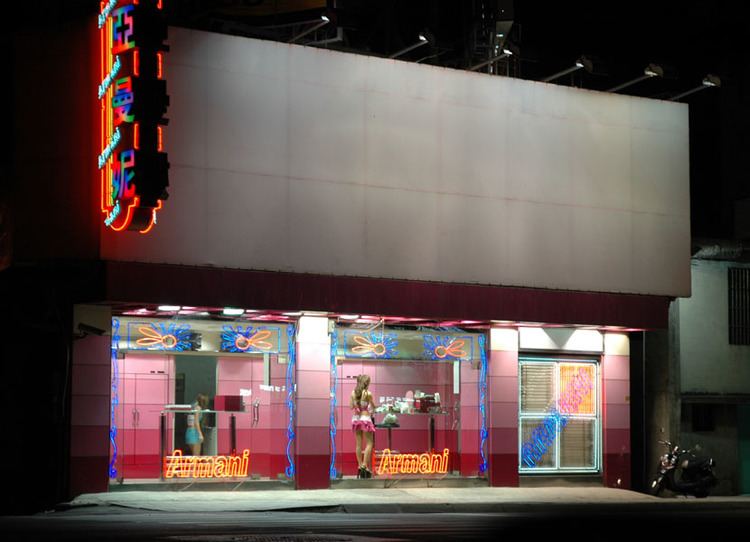Traditional Chinese 檳榔西施 Hanyu Pinyin | Simplified Chinese 槟榔西施 Wade–Giles pin-lang hsi-shih | |
 | ||
Hokkien POJ pin-nn̂g se-si/pin-nn̂g sai-si | ||
The term "betel nut beauty" (also betel nut girl – Chinese: 檳榔西施; pinyin: bīnláng xīshī; Pe̍h-ōe-jī: pin-nn̂g se-si) refers to what was once a common sight along roadsides in Taiwan: a young woman selling betel nuts and cigarettes from a brightly lit glass enclosure while wearing revealing clothing. The term in Chinese names the women after Xi Shi, the legendary beauty of imperial China's Spring and Autumn period. Though betel nuts are chewed in many regions of the Asia-Pacific, the betel nut beauty phenomenon is distinctly Taiwanese.
Contents
The original betel nut beauties were the "Shuangdong Girls" who, in the 1960s, brought glamour to the opening of the Shuangdong Betel Nut Stand in Guoxing Township, Nantou County. The success of the marketing strategy led competitors to follow suit, and by the end of the century betel nut beauties and their neon-topped kiosks were a trademark feature of Taiwan's cities and countryside. The kiosks appear in urban, suburban and rural settings alike.
As icons of Taiwanese culture, betel nut beauties appear frequently in art and film. Betelnut Beauty is the English title of the 2001 film Betelnut Beauty, and betel nut beauties figure prominently in the 2007 art film Help Me, Eros. In 2016, director Tony Xue released his film Betelnut Girls, with lead actors Peggy Tseng and Paul Hsu.
The practice is now more or less completely discontinued.
Definition and distribution
In a general sense, Betel nut beauty refers to any female pinang (betel nut) saleswoman wearing seductive clothing.
Flamboyant pinang kiosks decorated with flashing neon lights are a common sight on the north-south highway in the west of Taiwan and on its suburban roads. The primary targeted customers are lorry drivers who use pinang to keep from dozing off in long distance driving. Some shop owners started to hire girls dressed in sexy outfits to grab customers’ attention in this highly profitable competition. Rivals followed suit. As the level of competition got higher, fewer clothes were worn by the female vendors.
Apart from being scantily clothed, some Betel nut beautys also allowed customers to touch their bodies, putting them on a par with sex workers. However, this special kind of service was believed to be available only to customers who had purchased a certain amount of pinang.
Leaving aside the fear that these practices would generate crime, the presence of Betel nut beauty also distracted drivers and caused more car accidents. There was an instance of driver being prosecuted for murder for this reason.
Taiwanese betel nut culture
Pinang refers to the seed of Areca catechu, or Betel palm, which, like Cocos nucifera (or the Coconut palm), belongs to Arecaceae (the palm family) and is a kind of evergreen tree whose trunk can grow as tall as twenty meters. The word Pinang originated from Indonesian. Pinang was initially used as a kind of herbal plant, although in modern times it is mostly taken as a kind of pick-me-up.
Pinang chewing enjoys widespread popularity in Taiwan. It is conservatively estimated that over a hundred billion New Taiwan Dollars are spent annually on this so-called “Taiwanese chewing gum” by the “red-lip clan” (people addicted to pinang chewing). According to the Council of Agriculture, as many as seventy farms have joined this lucrative pursuit by planting pinang trees, which makes pinang the most important economic crop in Taiwan since the nineties. However, the upsurge of pinang planting causes problems with soil and water conservation on the hillside land. It was also found that the Taiwanese way of consuming pinang significantly enhances its potential to cause cancer. Although the cons far outweigh the pros, chewing pinang is still a prevailing custom in Taiwan to this day. It is used by both the working class and professionals, by both men and women. Because of the high consumption values, vendors of pinang soon came to occupy every possible spot on the streets of Taiwan. Vigorous competition eventually led to the creation of “Betel nut beauty” culture.
Controversy
Controversy surrounding betel nut beauties generally centers on two questions:
- the propriety of their revealing dress in public places and
- whether their dress marks them as victims of exploitation.
Betel nut beauties often hail from agricultural and working-class sectors of Taiwanese society. This has led some critics to regard their revealing dress as a sign of exploitation. Other observers, such as Josephene Ho, coordinator of the Center for the Study of Sexuality at National Central University, see betel nut beauties as self-empowering: young women with few resources who better their economic situation by employing a marketing technique that requires confidence.
Crackdown
In 2002, local governments in Taiwan started to impose laws or regulations covering the dress code of Betel nut beauty, prohibiting the wearing of over-revealing clothes. Taipei city was the first to initiate the change. This was then followed by Taoyuan County (now Taoyuan City) and metropolitan cities like Taichung, Tainan, and Kaohsiung, until Betel nut beauty all but disappeared. Nowadays they can only be found sporadically in the suburbs and around motorway interchanges. Even there, the clothes they wear are no longer so revealing.
Some Betel nut beauties are high school dropouts and their jobs represent the principal source of income for their families. Most have difficulty finding a job in a convenience store because they lack an educational qualification or because of age restriction; some choose to enter this profession for its higher pay.
